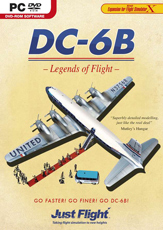Introduction
and a bit of History
With the turning of the tide of WWII in 1944, the Douglas
corporation started to think about post-war commercial aviation.
Using the 4-engined DC-4 as a basis, the designers developed the
DC-6.
The U.S. Army Air Force took an immediate interest in this
for military airlift operations. The USAAF commissioned a
proto-type , the XC-112, which first flew in February 1946. By
this time, of course, the war was over, so Douglas revised the
design as a long range airliner, and the first production DC-6
was in the air in June of that year.
United Air Lines took the
first delivery around 10 months later, but problems with the
fuel venting system, which caused 2 fuselage fires, grounded
production DC-6 aircraft for four months. After existing
airframes had been modified, the DC-6 production continued to a
total of more than 170 aircraft.
In 1947, President Truman had replaced his C-54 Skymaster (DC-4)
with a DC-6 Liftmaster (VC-118). When the more powerful
(water/methanol injection) R-2800-CB17 engines became available,
Douglas were able to lengthen the airframe by 60 inches to
produce the DC-6A Liftmaster freighter and a similar passenger
version, the DC-6B. With the commencement of hostilities in
Korea, military interest in the C-118 and R6D (Navy) increased
and more than 160 were built.
After its first flight in February 1951, Pan Am used a fleet of
DC-6B aircraft to inaugurate its first trans-Atlantic tourist
class flights, starting in 1952. Unlike the older Lockheed
Constellation, the DC-6B was able to make the eastward flight
non-stop, although westward flights still required a refuelling
stop in Newfoundland because of prevailing winds. Several
European carriers, including Swiss-Air and Sabena, followed
Pan-Am with the DC-6B.
The DC-6 was Douglas's most successful 4-engine prop - total
production exceeded 700 aircraft. In the fifties, passenger
service DC-6's began to be replaced by the longer range DC-7's
and, subsequently, by DC-8 and Boeing 707 jetliners. However,
cargo operators continued to use the DC-6 because of fuel
efficiency and practicality. In fact, many are still in use
today - a tribute to the design skills of Douglas and the
durability of the Pratt & Whitney R-2800 Double Wasp engine.
Well, that's the real aircraft - what about the Just
Flight/Aeroplane Heaven version? Read on!
Download and Installation
The Just Flight DC-6B is the latest in their "Legends of Flight"
series and can purchased and downloaded from their website.
There is also a boxed DVD version available, if you prefer.
I
decided on the former as the files are not too large - the Base
pack is 210 Mbytes and the Expansion pack another 156 Mbytes.
Downloading only took a few minutes on our broadband and
installation with the Just Flight on-line registration procedure
was, as usual, quite painless.
I always check that the
auto-installer has done its job correctly before starting the
sim and, sure enough, the new aircraft were in the
...\SimObjects\Airplanes folder as expected. No new entries in
the Gauges folder but a new entry in Effects for the starting
smoke for the R-2800's. I also found the DC-6B Manuals (English
and German versions) as pdf files in the Just Flight folder.
As I was doing this Review, Just Flight announced the Cargo
Expansion Pack of around 90 Mbytes, so I've included these
additional variants in the review.
DC-6B Models and Aircraft
Variants
In all, the DC-6B comes in 5 types with 26 individual liveries -
16 commercial airliners, domestic and international, in the Base
pack and a further 10 in the Expansion pack, which includes 4
military variants. The Cargo Expansion Pack adds 6 more
passenger/cargo variants. Here's a summary:
| Domestic Day-plane (5 window) | |
| • United Air Lines - Circa 1957 | • American Airlines - Circa 1956 |
| • Sterling - Circa 1968 | • Northwest - Circa 1956 |
| • Northeast Air Lines -Circa 1958 (Exp. Pack) | • National - Circa 1961 (Exp. Pack) |
| • Cathay Pacific - Circa 1958 (Exp. Pack) | |
| Intercontinental (4 window) | |
| • Balair - Circa 1966 | • JAL - Circa 1960 |
| • Sabena - Circa 1968 | • Red Bull - Circa 2011 |
| • Pan Am - Circa 1961 | • British Eagle - Circa 2011 |
| • Swissair - Circa 1957 (Exp. Pack) | • KLM - Circa 1959 (Exp. Pack) |
| • SAS - Circa 1956 (Exp. Pack) |
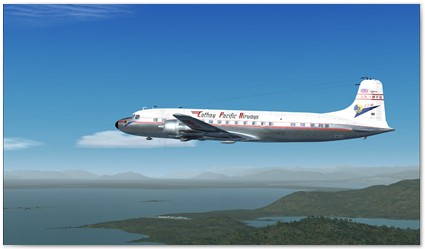 |
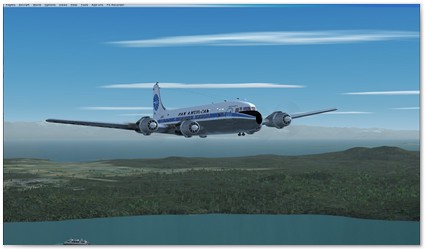
|
| C-118B (Military DC-6B) | |
| • VC-118B US Navy (131578) (Exp. Pack) | • VC-118B US Navy (128432) (Exp. Pack) |
| • VC-118B Early US Navy (128432) (Exp. Pack) | • VC-118A USAF (0-33300) (Exp. Pack) |
| Passenger/Cargo Variants of DC-6B (F) - from the Cargo Expansion Pack | |
| • Cayman Airways Cargo - Circa 1976 | • Alaska Airlines - Circa 1972 |
| • MartinAir Holland - Circa 1967 | • British United Airways - Circa 1960 |
| C118A Liftmaster - Cargo Expansion Pack | |
| • Everts Air Fuel - Circa 2011 | • Trans-Air Link - Circa 1983 |
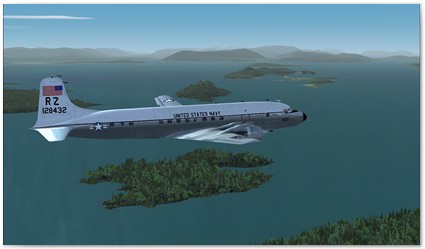 |

|
First Impressions
As with any new add-on, I had to get up close and personal at the earliest opportunity. What better way than to charter a British Eagle DC-6B from Southampton International (EGHI) for a sight-seeing trip around the Isle of Wight?
The VW micro-bus delivered me to the apron where the stewardess - oops, sorry! - flight attendant, was waiting on the steps to welcome me on board. She said, that as I was to be the only passenger, the flight crew had invited me to join them on the jump seat.
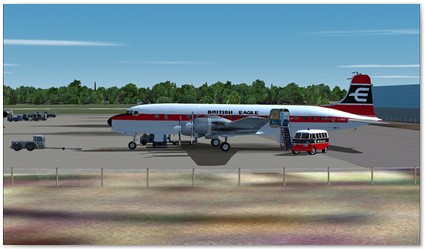 |
 |
The Double Wasps roared into life, the smoke bellowing from the vents across the soot-darkened wings, and we taxied to the active. With the throttles pushed forward, the noise of the engines increased and we started to roll until, at around 110 knots (no passengers or baggage aboard so 10,000 lbs below MTOW of 107,000 lbs) the captain rotated and began climb out.
The gear came up with a rumble when we'd established a rate of 500 fpm and flaps inboard at 140 knots. Turning to port, over the Solent, the co-pilot adjusted the propellers back to around 65% as the captain reduced power to 45 psi. Still climbing, we continued to turn inland and with the ADF set to 328 KHz, we proceeded to Blackbushe NDB. A couple of minutes later, the ILS sprang into life as the instrument picked up the EGHI signal, and we started a slow turn back towards Southampton.
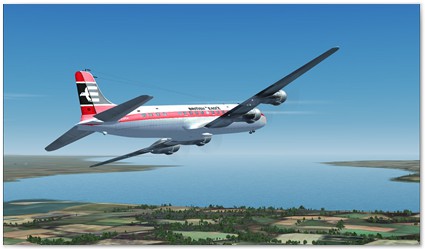 |
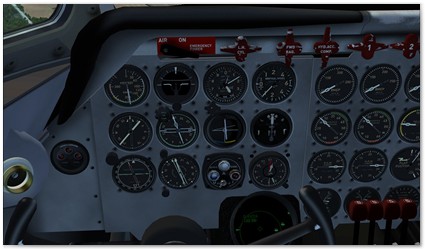 |
Easing back the throttle a little, the ILS was captured, the flaps came out to 20 degrees and we started the descent. In no time, it seemed to me, at least, we were over the numbers and back on terra firma.
The captain applied reverse thrust, with the throttles right back, and we slowed to around 40 knots when the brakes were applied and the throttles returned to idle. An excellent introduction, thanks to the experience of the flight crew. I was left wondering how long it would take me to get that proficient!
Exterior Model
Someone once said: "The devil is in the detail" and in the flight-sim world, this separates those models that look real and those that, well, look like models. I've got to say that Aeroplane Heaven have done an excellent job with the DC-6B. Walking around the aircraft as she stands on the ramp is a real pleasure - the attention to detail with the engines, landing gear, aerials, etc. is very impressive.
The various livery textures have been meticulously prepared and applied carefully - no transition blemishes to reduce that all important immersion factor. The bare metal surfaces on the engines and wings are rendered nicely and set off the paintwork of the various liveries well. In the air, she looks just as good and the developers have included additional View-Points - watching the aircraft touch down from the Landing Gear View is particularly exciting.
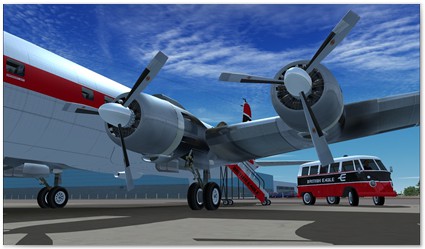 |
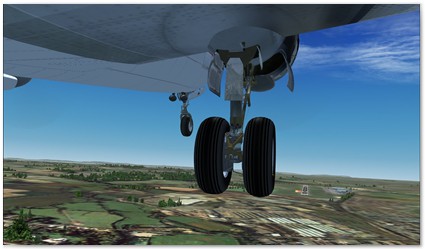 |
Virtual Cockpit and Interior Model
After a few hours in the DC-6B's VC I felt quite at home. The instrument layout is good and most of the switches and gauges are easy to see and use.
The complexity of flying a 4 engined aircraft is apparent when you look around the office - quite a challenge when you're on your own. Starting up successfully from a cold and dark cockpit gives you a real sense of achievement - the developers have included nearly every step in the procedure.
Taxi-ing to the active needs care, like any large aircraft, but once you're there, taking off using the VC is straightforward. Landing, obviously, takes more practice, but you quickly get a feel for the aircraft's position on approach despite having a limited view of the threshold.
As with the majority of add-on aircraft these days, the DC-6B is flown from the VC - no 2-D Panel is included. The navigation gauges have to be adjusted from the VC and this is probably my main criticism of the DC-6B - it isn't easy to master the nuances of setting an OBS value on a gauge which doesn't have an OBS knob! In fact the Omni Bearing Setting can be adjusted via the adjacent instrument - so, just a technicality, really.
The developers have made GPS navigation available, together with an auto-pilot in the DC-6B, but I still prefer the old-fashioned methods. There is a pop-up Radio Panel, which makes tuning a lot easier than using the VC's radio knobs. This pop-up is required for tuning the ADF-1 frequency as the animated lever hides the read-out for some ranges.
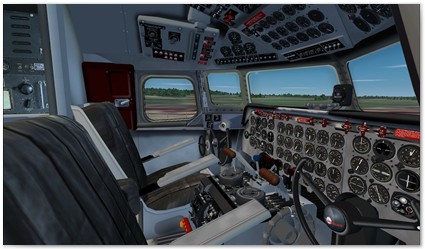 |
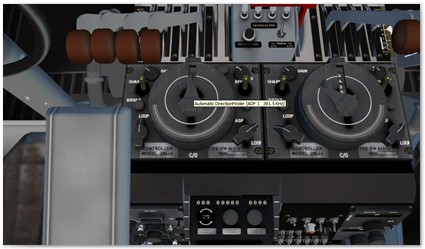
|
In the VC, each engine has individual Mixture and Propeller levers on the main console. You need to make adjustments to the propeller and Mixture controls for each engine individually rather than adjusting a single lever. I found that a bit of a struggle to start with, but then, that's what is necessary in the real aircraft, and it does get easier with practice. Maybe a pop-up Engine Quadrant gauge would be useful here, like the Radio pop-up. This could include 'Master' levers for Mixture and Propeller controls - this would help with setting the same mixture/propeller percentage across all engines, simultaneously.
The VC includes a radio operators console, which is non-operative. The commercial DC-6B models include a single passenger cabin, complete with the glamorous flight attendant we've grown to love from other Just Flight products. The cargo variants don't have an interior model for the either the passenger cabin or the forward or aft cargo holds, but the level of exterior model detail adequately compensates for this.
 |
 |
Flight Dynamics
As you'd expect, the DC-6B is a much more stately aircraft than her older sister, the DC-3, but if you're used to flying the Dizzie, you'll not have many problems.
The performance of the 4 Double Wasps makes the DC-6B some 30% faster and almost doubles the range of the DC-3, but, of course, you need a longer runway for take-off and landing. In flight, the DC-6B feels more stable than the DC-3 and less subject to turbulence effects, due to increased mass.
I found the handling of the Just Flight model to be quite manageable as long as manoeuvres were made relatively smoothly. As I've said already, take-off and landing in normal conditions, is reasonably straightforward. I did try some more difficult approaches (BIIS and VQPR) and I enjoyed the experience immensely - the DC-6B behaves in a predictable and, therefore, manageable way.
At the detailed level, Just Flight have modelled the engine performance well - you need a fine touch on the mixture controls to climb above 12,000 feet - and the flight ceiling of 22,000 feet is realisable. All in all, she is a pleasure to fly.
Animations
Basic animations, like ailerons, elevators and rudder are well done, and the landing gear retract speed is realistic. VC switches and gauges are neatly executed although the quarter light windows do move a little faster than you'd expect!
Exterior cabin and baggage doors are all animated and, in addition, the flight attendant can move to the head of the passenger stairway, which appears when the appropriate VC switch is toggled. As with previous offerings, the VW Van also appears in the carriers own livery, which is a bonus and very eye catching.
The 6 passenger/cargo variants (Cargo Expansion Pack) have animated cargo doors which reveal a colourful set of packing cases inside the holds. A passenger stairway and bright yellow truck appear when the control switch is toggled from the VC. Finally, for complete accuracy, Just Flight have removed the passenger windows in both the TAL and Everts models.
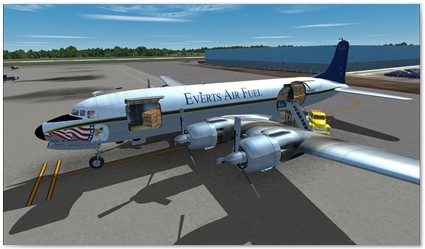 |
 |
PDF Manual
The DC-6B Manual is well written and straightforward to read. At 64 pages, with plenty of useful illustrations, you won't find it too daunting a prospect.
A quarter of the Manual introduces you to the DC-6B's history, installation, and the various models you'll discover in your hangar. Just about half the Manual deals with the operational aspects of managing the DC-6B in flight, and the description of the various cockpit panels is very detailed. You'll also find a section on flying the DC-6B and a summary of navigation aids and fuel management.
Those of you familiar with larger aircraft will find the Manual more than adequate. Just Flight do say that the Manual isn't really the right place for a detailed breakdown on navigation, but if you're a bit inexperienced in this area, flying the DC-6B will certainly encourage you to learn more about this subject - practice makes perfect!
Pluses and Minuses
The good points include excellent internal and external modelling, good frame rates and a very well behaved aircraft to fly. I thought the choice of variants reflected well the range of DC-6Bs, both functionally and historically, and the standard of texturing was also very good.
My only criticisms stem from the navigation gauges and their operation from within the VC. This, I guess, is down to personal preference and would be resolved completely by the inclusion of a couple of extra pop-up mini-panels ,or better still, a 2-D Panel. However, these points may not arise with other users, particularly those who tend to use the GPS for navigation.
Concluding Remarks
After analysing my FSX Logbook, I found that I'd been flying the DC-6B for nearly 30 hours - what with getting to grips with the flight characteristics, making a couple of videos and taking screenshots associated with this review. How time flies when you're enjoying yourself! And, yes, I thoroughly enjoyed putting the DC-6B through its paces - a most rewarding experience, indeed. Good to look at, straightforward to fly - even from the VC, which, for me, was a real bonus - and well deserving a place in my hangar.
![]()
Verdict
![]()
|
• External Model: • Internal Model: • Sounds: • Flight Characteristics: • Flight Dynamics: • Documentation: • Value for Money: |
9.5/10 9.0/10 9.5/10 9.0/10 9.5/10 8.5/10 9.0/10 |
Final Mutley's Hangar Score 9/10
For me, a score of 9/10 reflects my enjoyment in flying the DC-6B and I recommend her to you, whether you're an old hand at flying big-iron or a new-comer to the flight sim scene. I'm sure you won't be disappointed.
If you're interested in trying the DC-6B, then take a look at Just Flight's Demo's Page (http://www.justflight.com/demos)
David Williams
Review machine Spec: Q9400 2.67 GHz |
4Gb Ram |nVidia GeForce 8800 GT 512 Mb |Windows 7 64bit

